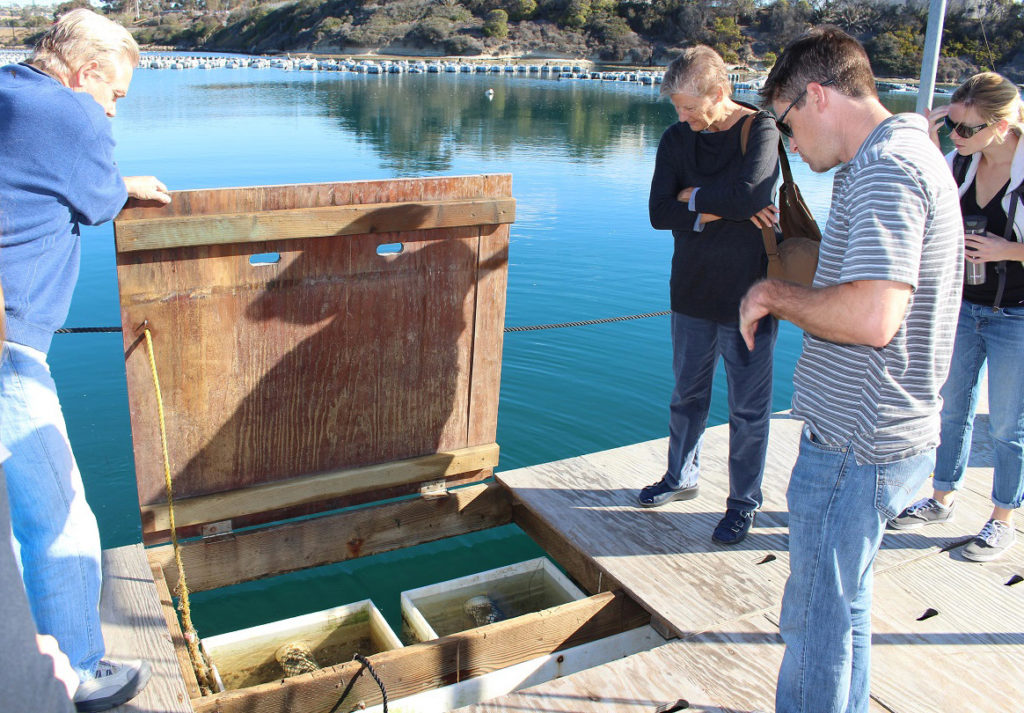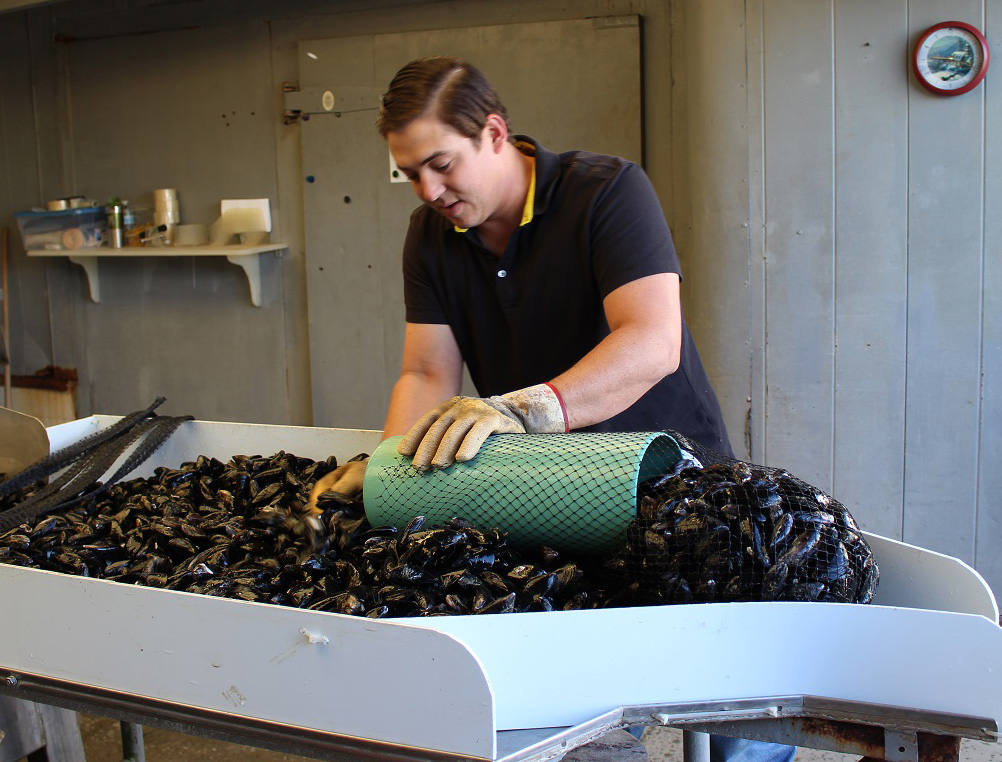Posted on OAP: NOAA funds shellfish farmers and scientists to expand Pacific Coast monitoring with $1.4 million over three years.
NOAA is providing a grant of $1.4 million over three years to help shellfish growers and scientific experts work together to expand ocean acidification (OA) monitoring in waters that are particularly important to Pacific coast communities such as in oyster hatcheries and coastal waters where young oysters are grown.
 Thomas Grimm, owner of the Carlsbad Aquafarm, shows the Southern California Coastal Ocean Observing System (SCCOOS) team the Floating Upwelling System (FLUPSY) he employs to grow young oysters. Credit: Southern California Coastal Ocean Observing System
Thomas Grimm, owner of the Carlsbad Aquafarm, shows the Southern California Coastal Ocean Observing System (SCCOOS) team the Floating Upwelling System (FLUPSY) he employs to grow young oysters. Credit: Southern California Coastal Ocean Observing System
Shellfish growers, hatchery owners and scientists will work together to strengthen their understanding of and ability to adapt to the impacts of ocean acidification on the Pacific Coast of the US, including Alaska. Carbon dioxide (CO2) emissions from the burning of fossil fuels, which are being absorbed by the ocean, are causing a change in ocean chemistry which has already been detected along this coast.
While current efforts have been likened to lights on a car, this grant will help them ‘turn the headlights on high’ on ocean acidification by increasing the number of shellfish growers and hatchery owners that have the capacity to detect changes. This will be done by training more people how to monitor OA and encouraging them to work together in communities of practice, developing more accurate and affordable sensors to measure these changes, and making the data from these sensors readily accessible.
This project builds off prior research supported by Integrated Ocean Observing System (IOOS) in 2013, which allowed shellfish growers and scientists to not only begin to detect, but adapt to, this change in ocean chemistry by monitoring seawater coming in to hatcheries to inform decisions about their operations. The current project, supported by NOAA’s IOOS and Ocean Acidification Program, is funding researchers at the University of Washington and Oregon State University in addition to technicians at the Southern California, Central California, Pacific Northwest and Alaska regional associations of IOOS to make ocean acidification monitoring sensors more accurate and affordable.
“[A shellfish operation] is expensive when you consider the amount of infrastructure, the cost of labor, equipment, seed, and the uncertainty that any crop could fail. Having information about water quality may play a critical role in the success of the operation,” says Margaret Pilaro Barrette, Executive Director of the Pacific Coast Shellfish Growers Association, who serves as the liaison between the shellfish growers, hatcheries and the scientists on the project. “Durable and uncomplicated monitoring devices, that aren’t expensive, are needed [by those in the industry].”
Dr. Burke Hales, a Professor at Oregon State University who studies chemistry in coastal waters, has been working with shellfish hatchery operators for years to understand how to effectively monitor these changes. He is the scientific expert on this project and developed the ‘Burkalator’, a gadget that allows users to detect changes in seawater chemistry, by measuring temperature, salinity, and CO2. These monitors are currently used in hatcheries in California, Oregon, Washington, and Alaska. Dr. Hales said he is excited to develop monitoring devices that are more affordable and that anybody can learn to run, but also recognizes the importance of having technical experts locally to help troubleshoot. This is one of the unique aspects of this project and is the key to building communities of practice around ocean acidification monitoring.

Staff from the Carlsbad Aquafarm package mussels for distribution. Photo Credit: Southern California Coastal Ocean Observing System (SCCOOS)
These communities of practice comprised of Burkalators (the monitoring technology), scientific experts, and hatchery operators can be found from Alaska to Southern California. The owner and operators at Alutiiq Pride Shellfish Hatchery in Seward, Alaska “are a phenomenal team,” says Ellen Tyler, Program Manager at Alaska’s regional Association, AOOS. This team raises oysters, geoducks, cockles, clams and scallops and is also doing research to see if blue and red king crab can be reared in the hatchery and then released in to the wild Alaskan waters. This work is extremely important seeing that studies have shown red king crab to be negatively impacted by acidification, species numbers have been declining, and Alaskan communities and high-latitude waters are highly vulnerable to ocean acidification.
Ocean acidification and its impacts have “really gotten the shellfish community, particularly the growers, to be involved and aware. You have to be extremely aware of your environment as a grower,” says Margaret Pilaro Barrette. “Many of those in this industry are 2nd, 3rd, 4th, and 5th generation shellfish growers, this is where they have grown up, and they are really attuned to what is going on and doing things that have been passed along from prior generations. We can learn more and do more. Many more people are starting to think about a more refined awareness of the environment where shellfish grow, through water quality monitoring and asking how can we help the critters we are growing? Should we be thinking more carefully about the food they are getting from their environment? Would anything help them grow better in stressful conditions?”
In California, shellfish growers will be working with scientific experts, and the California’s two regional associationsCenCOOS and SCCOOS to be able to “see a high CO2 event and take mitigating measures with their shellfish crops to lessen the negative impacts of ocean acidification,” says Aric Bickel, SCCOOS Program Manager. These groups are also aware that in California waters, acidification isn’t the only stressor shellfish farms have to contend with. Growers and the regional associations are also working to monitor and understand the impacts of other factors, such as nutrients used on agricultural and urban lands that end up in coastal waters and harmful algal blooms.
Dr. Jan Newton, Director of Pacific Northwest Association of Networked Ocean Observing Systems (NANOOS) andWashington Ocean Acidification Center co-Director, is leading the project. In Washington and Oregon, state funds are partially supporting regional technical experts for this work so that the federal dollars collectively go farther. She is excited about the potential for this approach to be exported to other regions like the US East and Gulf Coasts and the global community such as through the Global Ocean Acidification Observing Network (GOA-ON). “It is really exciting to have affordable technology, communities of practice, accessible data and a model that is exportable to the world,” she explains.
To learn more about this project: http://www.nanoos.org/documents/announcements/msi-announcement-oa.pdf